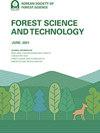Relationship of H/D and crown ratio and tree growth for Chamaecyparis obtusa and Cryptomeria japonica in Korea
IF 2.2
Q2 FORESTRY
引用次数: 2
Abstract
Abstract This study was conducted to suggest the necessity of regulated stand density control in order to maintain the ratio of height to diameter at breast height (H/D ratio) of Hinoki cypress (Chamaecyparis obtusa) and Japanese cedar (Cryptomeria japonica) in South Korea. A total of 2,000 (1,000 each) Hinoki cypress and Japanese cedar were cut from various regions of South Korea, and their diameter at breast height (DBH), height and clear length were measured. The two species’ regional means of H/D ratio and crown ratio were then computed and compared to find the relationship with tree growth. The result of analyzing the relationship between the H/D ratio and tree growth by DBH class is as follows, 77.0% for small DBH class, 62.5% for medium DBH class, and 45.9% for large DBH class, with overall mean of 61.8%. The annual means of DBH growth were 4.6 mm, 7.4 mm, and 8.2 mm respectively for small, medium, and large DBH classes. As the DBH class went up, the H/D ratio decreased, showing a negative correlation (p < 0.0001) with the tree growth rate. However, the crown ratio showed a significant correlation with tree growth. Japanese cedar’s H/D ratios by DBH class were 100.5% for small, 74.9% for medium, and 53.6% for large, while its mean annual DBH growth were 5.1 mm, 7.6 mm, and 10.0 mm, from small to large DBH class respectively. Similar to that of Hinoki cypress, Japanese cedar’s H/D ratio showed a negative correlation with the growth rate (p < 0.0001), but no significant relationship could be established between the crown ratio and the tree growth. In both arboreal species, the correlation between the H/D ratio and growth rate is negative, and no significant correlation could be formulated between crown ratio and tree growth. In conclusion, both tree species tended to have a higher H/D ratio and a lower growth rate in small DBH class, while H/D ratio decreased and growth rate increased As DBH class got larger.韩国长尾杉和柳杉的H/D、冠比与树木生长的关系
摘要本研究旨在探讨调节林分密度对维持韩国红柏(Chamaecyparis obtusa)和杉木(Cryptomeria japonica)林高径比(H/D)的必要性。从韩国各地采伐了2000株(各1000株)的日本柏树和日本雪松,测量了它们的胸径、高度和净长。然后计算两种树种的H/D比和冠比的区域平均值,并进行比较,找出与树木生长的关系。对不同胸径级的胸径比与树木生长的关系进行分析,结果表明:小胸径级为77.0%,中胸径级为62.5%,大胸径级为45.9%,总体平均值为61.8%。小林、中林和大林的年平均胸径增长分别为4.6 mm、7.4 mm和8.2 mm。随着胸径等级的增加,H/D比值降低,与树木生长率呈负相关(p < 0.0001)。冠比与树木生长呈极显著相关。小林、中林和大林的胸径比分别为100.5%、74.9%和53.6%,小林和大林的年均胸径增长量分别为5.1 mm、7.6 mm和10.0 mm。与白木相似,杉木的H/D与生长速率呈负相关(p < 0.0001),但树冠比与树木生长速率无显著相关。在两种乔木树种中,H/D比与生长速率均呈负相关,冠比与树木生长速率无显著相关。综上所述,两树种在小胸径级均有较高的高径比和较低的生长率的趋势,随着胸径级的增大,高径比减小,生长率增大。
本文章由计算机程序翻译,如有差异,请以英文原文为准。
求助全文
约1分钟内获得全文
求助全文

 求助内容:
求助内容: 应助结果提醒方式:
应助结果提醒方式:


